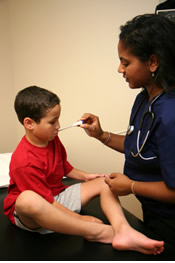
A study[i]funded by the Robert Wood Johnson Foundation found the economic recession has increased demands placed on the United States healthcare safety net[ii] – a study of five metropolitan communities saw demand has been less severe than expected. On the surface, this may appear surprising; it shouldn’t.
Our hypothesis nearly two years ago called for the economic recession greatest healthcare impact to be experienced by the middle class. These consumers have little understanding of healthcare resources and their socioeconomic standing, in most cases, precludes their psychosocial ability to use safety net services and products.
Safety net health services have used Federal grants to build community health centers. Programs directing patients to primary care physicians and away from emergency departments have been very popular. The American Recovery and Reinvestment Act (2009) has put funding into the system thereby offsetting state-based reductions in funding. Industry leaders no less than a year ago announced the safety net would be hit hard by the recession and stretched to its limits. This study find that this hasn’t happened. Yet.
Small and large businesses have made resource cutbacks over the last twelve to eighteen months in an effort to survive the economic recession. Economists and related pundits believe the economy is improving albeit a slow progressive journey. The definition of productivity has undergone a transformation during this period. Doing more with less is echoed in offices, factories, blue-collar and white-collar positions. The aggressiveness of the recovery is slow therefore the speed of work force expansion will creep along.
I have observed the formation of two safety net providers the past year – one a community health center and the second a multidisciplinary, school based health clinic with sliding scale and offering physician and mental health services for youth and families. These programs benefited from a desire by neighboring health systems to reduce their emergency department utilization as well as the ARRA. Both sites of care have grown quickly with the majority of their patients individuals who previously had not sought a primary care physician or ongoing physician and mental health services. The faces – more importantly the zip codes, in the waiting room have not changed.
Extension of unemployment benefits, COBRA benefits, and other stimulus programs have definitely enabled a segment of the community to retain access to the healthcare system. The torpid economic recovery will create a series of domino events:
· Expanded and extended COBRA benefits will be terminated.
· Workforce expansion will occur in 2011 – 2012.
· Philanthropic gifts for healthcare programs decrease; the greatest impact will be multiyear grants concluded early or continued at lower funding.
· Personal savings and/or tangible assets for those unemployed run out.
In 2008 – 2009 a perfect storm occurred – dramatic shifts in interest income, presidential elections, and interest in healthcare reform. The conclusion of that story has yet to be written. A second perfect storm event may occur – the events listed above occurring at the same time. Safety net services, at that point, will be in serious condition impacting lower socioeconomic populations and middle class consumers will be without support, the will, or the understanding of how to access healthcare services.
It is essential to understand utilization and access of safety net healthcare services over time and not for a limited, twelve month period. The Economic Recession: Early Impacts on Health Care Safety Net Providers paints a well deserved and accurate portrait of our current state. The inclusion of “early” is essential in the study title. The short-term agenda should incorporate:
1. Funding of safety-net healthcare services;
2. Expansion of community health clinics beyond low-income geographies;
3. Continued efforts toward efficiency, productivity, cost-management;
4. Consumer education on how, when, and where healthcare services can be accessed;
5. Framing psychosocial communication for middle class consumers of community-sponsored health care services.
The health status of the economy is improving; the health status of the community is still in a tenuous position.
Who is on call?
[i] The Economic Recession: Early Impacts on Health Care Safety Net Providers, Research Brief No. 15, January 2010. Center for Studying Health System Change, January 2010. Authors: Laurie E. Felland, Peter J. Cunningham, Genna R. Cohen, Elizabeth A. November, Brian C. Quinn. Study funding from the Robert Wood Foundation.
[ii] “A safety net hospital or health system provides a significant level of care to low-income, uninsured, and vulnerable populations. Safety net hospitals are not necessarily distinguished from other providers by ownership – some are publicly owned and operated by local or state governments and some are non-profit. Rather, they are distinguished by their commitment to provide access to care for people with limited or no access to health care due to their financial circum-stances, insurance status, or health condition.”—National Association of Public Hospitals and Health Systems.
Leave a Reply